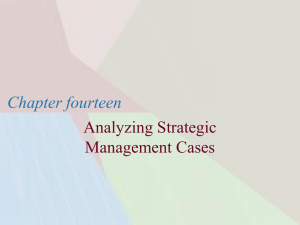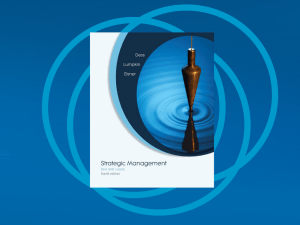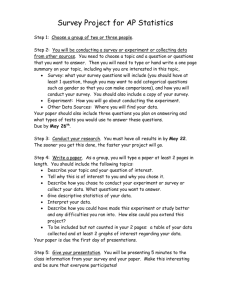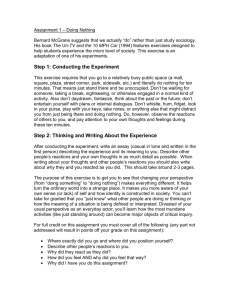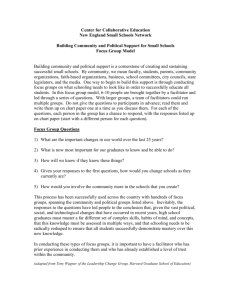Chapter 9
advertisement
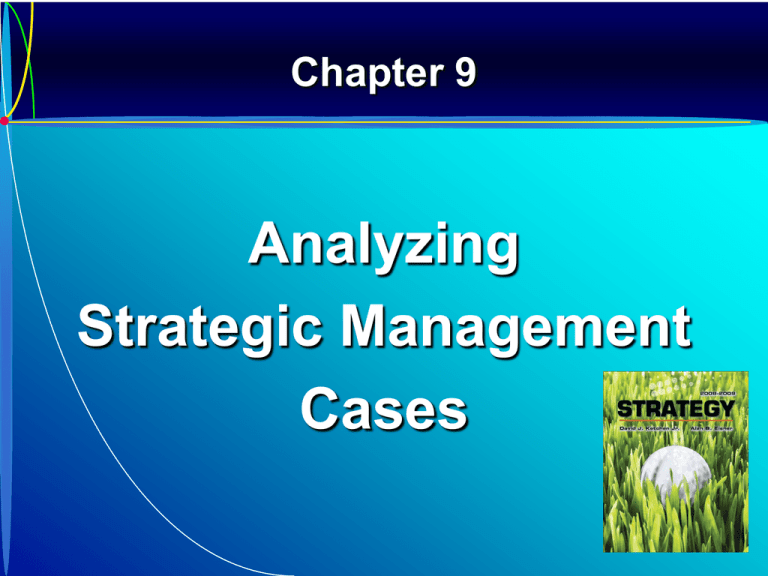
Chapter 9 Analyzing Strategic Management Cases What are Strategic Management Cases? Case – a detailed description of a challenging situation faced by an organization, usually including a chronology of events and extensive support materials Case Analysis – a method of learning complex strategic management concepts by placing students in the middle of an actual situation and challenging them to figure out what to do 9-2 Why do case analysis? Simulates real-world experience Complements other learning methods Trains one to analyze, make decisions Improves skills Differentiate Speculate integrate 9-3 Why Analyze Strategic Management Cases? Why do some firms succeed and others fail? Why are some companies higher performers than others? What information is needed in the strategic planning process? How do competing values and beliefs affect strategic decision making? What skills and capabilities are needed to implement a strategy effectively? 9-4 Skills Developed from Case Analyses Differentiate Evaluate many different elements of a situation at once Differentiating between the factors that are influencing the situation Understanding that problems are often complex and multilayered Dig deep Being too quick to accept an easy solution will probably fail to get to the heart of the problem 9-5 Skills Developed from Case Analyses Speculate Envision explanation that might not readily be apparent Imagine different scenarios Contemplate the outcome of a decision Deal with uncertainty and incomplete knowledge Missing data Information may be contradictory Speculate about details and consequences that are unknown 9-6 Skills Developed from Case Analyses Integrate Look at the big picture Have an organization-wide perspective Integrate information into one set of recommendations affecting the whole company Changes made in one part will affect the others Integrate the impact of various decisions and environmental influences on all parts of the organization 9-7 How to Conduct a Case Analysis Prepare for a case discussion Do your homework Investigate Analyze Research potential solutions Gather the advice of others Become immersed in facts, options, and implications 9-8 How to Conduct a Case Analysis Put yourself “inside” the case Think like an actual participant Strategic decision maker Board of directors Outside consultant Try different perspectives One of the most challenging is as a business founder or owner Hiring an outside consultant may not be an option 9-9 Five Steps for Conducting a Strategic Management Case Analysis 1. 2. 3. 4. 5. Become familiar with the material Identify problems Conduct strategic analysis Propose alternative solutions Make recommendations 9-10 Five Steps for Conducting a Strategic Management Case Analysis Step 1: Become familiar with the material Read quickly through the case one time Use initial read-through to assess possible links to strategic concepts Read the case again, making notes Evaluate application of strategic concepts After forming first recommendation, thumb through the case again to assess consequences of actions you propose 9-11 Five Steps for Conducting a Strategic Management Case Analysis Step 2: Identify problems Some cases have more than one problem Avoid getting hung up on symptoms Articulate the problem Writing down a problem statement gives you a reference point when you proceed through case analysis Some problems are not apparent until after you do the analysis 9-12 Five Steps for Conducting a Strategic Management Case Analysis Step 3: Conduct strategic analyses Determine which strategic issues are involved Use strategic tools to conduct the analysis Five Forces analysis Value chain analysis Contingency frameworks Financial analysis Test your own assumptions about the case 9-13 Financial Ratio Analysis Techniques Short-term solvency (liquidity) ratios Current ratio Quick ratio Cash ratio Long-term solvency (leverage) ratios Total debt ratio debt-equity ratio Equity multiplier Times interest ratio Cash coverage ratio 9-14 Financial Ratio Analysis Techniques Asset utilization (turnover) ratios Inventory turnover Days’ sales in inventory Receivables turnover Days’ sales in receivables Total asset turnover Capital intensity Profitability ratios Profit margin Return on assets (ROA) Return on Equity (ROE) Market value ratios Price-earnings ratio Market-to-book ratio 9-15 Five Steps for Conducting a Strategic Management Case Analysis Step 4: Propose alternative solutions Develop a list of options first without judging them “Do nothing” may be a reasonable alternative Evaluate alternatives Can the company afford it? Is the solution likely to evoke a competitive response? Will employees accept the change? How will it affect other stakeholders? How does it fit with the vision, mission, objectives? Will the culture or values of the company change? 9-16 Five Steps for Conducting a Strategic Management Case Analysis Step 5: Make recommendations Make a set of recommendations that your analysis supports Describe exactly what needs to be done Explain why this course of action will solve the problem Include suggestions for how best to implement the proposed solution The solution you propose must solve the problem you identified 9-17 How to Get the Most from Case Analysis Keep an open mind Take a stand for what you believe Draw on your own personal experience Participate and persuade Be concise and to the point 9-18 How to Get the Most from Case Analysis Think out of the box Learn from the insights of others Apply insights from other case analyses Critically analyze your own performance Conduct outside research 9-19 Preparing an Oral Case Presentation Organize your thoughts Emphasize strategic analysis Be logical and consistent Defend your position Share presentation responsibilities 9-20 Preparing a Written Case Analysis Be thorough Coordinate team efforts Avoid restating the obvious Present information graphically Exercise quality control 9-21 Case Analysis Case 1 Enron: On the Side of Angels “We’re on the side of angels. We’re taking on the entrenched monopolies. In every business we’ve been in, we’re the good guys.” -- Jeffrey Skilling, President and CEO, Enron Corporation Background Began as natural gas distribution co. Evolved into financial services firm Aggressive culture Excessive spending Claimed revenues of $111B in 2000 Named “America’s Most Innovative Company” for 6 consecutive years (1996-2001) by Fortune Named to Fortune’s “100 Best Companies to Work for in America” list Share price > $90 Key Problems Organizational culture/leadership/ethics ◦ Quotes from executives ◦ Personnel practices ◦ Reward systems Unethical financial arrangements ◦ Special Purpose Entities (SPEs) ◦ Mark-to-Market accounting Corporate governance ◦ Oversight of management Analysis: PEST Political ◦ Lobbied for deregulation ◦ $7M in contributions ◦ Clinton/Bush era Societal Economic ◦ Bull market ◦ Deregulation of markets ◦ “Making markets” Technological ◦ Excess ◦ Dot-com bubble ◦ 9/11/2001 ◦ EnronOnline Analysis: Five Forces Barriers to Entry ◦ High – oil/gas ◦ Low – tech/financial services Substitute Products ◦ Commodities markets Suppliers Buyers Competitors ◦ Plenty of financial services firms available Analysis: Value Chain Marketing ◦ Great reputation Service ◦ Culture ◦ Opportunistic ◦ Low ethics/improper controls/fraud ◦ Branching out to offer more services Procurement ◦ Purchase suppliers Technology development ◦ EnronOnline General administration Human resource management ◦ Peer Review Committee (PRC) ◦ Compensation levels ◦ Benefits Analysis:VIRO Valuable ◦ Oil/gas Difficult to Imitate ◦ Very diverse Rare ◦ Many other gas and financial services firms Well-Organized ◦ Successful, but opaque Analysis: SWOT Strengths ◦ ◦ ◦ ◦ ◦ Lost focus on core competencies ◦ Corporate ethics ◦ Financial controls Innovative Talented personnel Charismatic leadership Goal-oriented ◦ BOD governance ◦ Conflicts of interest ◦ Steady growth history ◦ Excellent reputation Opportunities ◦ Deregulation ◦ Emerging markets Weaknesses Threats ◦ Low barriers to entry ◦ Market analysts Alternatives Focus on profitable entities/core competencies Disclose SPEs, properly book assets/debts Find independent auditors Replace executive management Remove other fraudulent employees Replace BOD with independents Establish new HR practices Promote new culture of ethics (through actions) Recommendations Focus on profitable entities/core competencies Disclose SPEs, properly book assets/debts Find independent auditors Replace executive management Remove other fraudulent employees Replace BOD with independents Establish new HR practices Promote new culture of ethics (through actions) Fallout Share price < $.50 Employees, investors lost $ Bankruptcy Criminal charges to executives Arthur Anderson LLP Audit/consulting companies WorldCom, etc. Sarbanes-Oxley Act Sarbanes-Oxley Act ◦ Stronger penalties for fraud ◦ Public companies can no longer make loans to management ◦ More transparency to financial statements reported to public ◦ Public companies must maintain a stronger independence from their auditors ◦ Public companies must audit and report on financial internal control procedures

